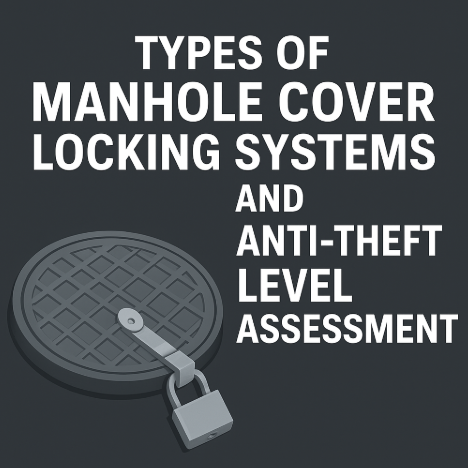In modern urban infrastructure, manhole covers play a critical role in ensuring safety, accessibility, and system protection. However, theft and unauthorized access remain major challenges for municipalities and industries. To address these issues, engineers have developed multiple locking systems for manhole covers, each designed to enhance security while maintaining practicality. This article analyzes the types of manhole cover locking systems and evaluates their anti-theft levels from a professional perspective.
Common Types of Manhole Cover Locking Systems
1. Bolt Locking Systems
Bolt-based mechanisms are among the most traditional solutions. They involve steel or stainless-steel bolts that secure the cover to the frame. While simple and cost-effective, their main drawback is time-consuming access during maintenance. However, they still provide a moderate level of anti-theft protection.
2. Hinge and Locking Pin Systems
Hinged manhole covers with integrated locking pins improve operational safety by preventing sudden dislodgment. They also reduce the risk of theft since removal requires specialized tools. This system offers a higher level of security and durability compared to bolts.
3. Key-Operated Locking Systems
Some covers include key-based locks, often designed with unique, non-standard keys. These systems are widely used in restricted-access areas such as power plants or telecom installations. Their anti-theft rating is high, but they require strict key management to remain effective.
4. Magnetic Locking Systems
Modern designs feature magnetic locks that require specific unlocking devices. This technology significantly enhances security since it prevents tampering with conventional tools. Municipalities often adopt these systems in high-risk theft zones.
5. Integrated Anti-Lift Mechanisms
Certain composite and ductile iron covers are designed with anti-lift grooves or spring systems that prevent lifting without proper tools. These offer a practical solution with minimal additional cost, making them ideal for large-scale use.
Anti-Theft Level Assessment
When evaluating the anti-theft performance of locking systems, engineers consider several factors:
- Resistance to forced removal – How well the system withstands crowbars, hammers, or cutting tools.
- Accessibility for authorized personnel – Whether the locking mechanism allows quick yet controlled access.
- Maintenance requirements – Systems that require fewer adjustments offer better long-term reliability.
- Cost-to-security ratio – Municipalities must balance budget constraints with security needs.
Based on these factors, magnetic and key-operated systems achieve the highest anti-theft level, while bolt and pin systems provide moderate protection. Integrated anti-lift designs serve as a cost-effective middle ground.
Market Trends and Future Innovations
With the growing demand for smart city infrastructure, locking systems are evolving beyond traditional mechanical solutions. Manufacturers are developing smart locking systems with electronic access control, IoT-based monitoring, and real-time tamper alerts. These innovations not only improve security levels but also reduce operational risks.
Conclusion
The choice of a manhole cover locking system depends on the application environment, security requirements, and maintenance budgets. Bolt and pin systems remain reliable for low-risk areas, while magnetic and key-operated locks provide robust anti-theft protection for critical infrastructure. As urban areas expand, the industry trend is shifting toward smart, integrated security designs that balance durability, efficiency, and advanced theft prevention.
By carefully assessing locking options, municipalities and industries can significantly improve infrastructure safety while reducing theft-related risks.





